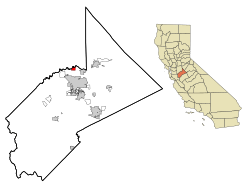Del Rio, California facts for kids
Quick facts for kids
Del Rio
|
|
|---|---|

Location in Stanislaus County and the state of California
|
|
| Country | |
| State | |
| County | Stanislaus |
| Area | |
| • Total | 2.05 sq mi (5.31 km2) |
| • Land | 2.00 sq mi (5.17 km2) |
| • Water | 0.05 sq mi (0.14 km2) 12.17% |
| Elevation | 128 ft (39 m) |
| Population
(2020)
|
|
| • Total | 1,399 |
| • Density | 700.55/sq mi (270.42/km2) |
| Time zone | UTC-8 (Pacific (PST)) |
| • Summer (DST) | UTC-7 (PDT) |
| ZIP code |
95367
|
| Area code(s) | 209 |
| FIPS code | 06-18695 |
| GNIS feature ID | 1853384 |
Del Rio is a small community in Stanislaus County, California, in the United States. Its name comes from Spanish, meaning "Of The River." It's known as a census-designated place (CDP). This means it's an area that looks like a town but isn't officially governed as one.
Del Rio is located near the Del Rio Country Club. In 2020, about 1,399 people lived there. It is part of the larger Modesto area.
Contents
Where is Del Rio Located?
Del Rio is found in California, near the coordinates 37°44′47″N 121°0′42″W / 37.74639°N 121.01167°W. It covers a total area of about 2.1 square miles (5.3 square kilometers). Most of this area is land, but a small part, about 0.3 square miles (0.8 square kilometers), is water.
Who Lives in Del Rio?
Del Rio is home to a diverse group of people. The population has grown over the years.
Population Changes Over Time
The number of people living in Del Rio has slowly increased.
- In 2000, there were 1,168 residents.
- By 2010, the population grew to 1,270 people.
- The most recent count in 2020 showed 1,399 people living in Del Rio.
Community Makeup
In 2010, most residents in Del Rio were White, making up about 80.9% of the population. There were also people of Asian (11.3%), African American (2.0%), and Native American (0.4%) backgrounds. About 8.4% of the population identified as Hispanic or Latino.
Most people in Del Rio live in family homes. In 2010, about 29.7% of homes had children under 18 living there. The average household had about 2.62 people. The median age in Del Rio was around 50.6 years old, meaning many adults and older people live there.
Planning for Del Rio's Future
Local leaders and planners have thought about how Del Rio should grow. Back in 1992, Stanislaus County created a plan for the area. This plan aimed to keep Del Rio's calm, spread-out feel. It focused on having good homes, farms, and open spaces.
The plan also looked at protecting the environment. It emphasized taking care of the areas along the Stanislaus River. It also considered how future buildings and roads might affect the air quality. These plans help make sure Del Rio grows in a smart and healthy way.
See also
 In Spanish: Del Río (California) para niños
In Spanish: Del Río (California) para niños



